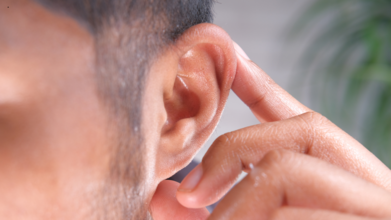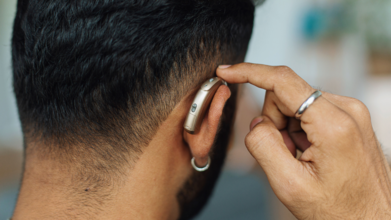- Health Conditions A-Z
- Health & Wellness
- Nutrition
- Fitness
- Health News
- Ayurveda
- Videos
- Medicine A-Z
- Parenting
- Web Stories
Inner Child: How ‘Be a Good Girl’ and ‘Boys Don’t Cry’ Create Adults Who Struggle to Say What They Really Feel

When was the last time you said yes when you wanted to scream no? Or brushed off your tears with an “I am fine” when you were anything but? If that sounds familiar, chances are your inner child is still living by the outdated scripts of “Be a good girl” or “Boys don’t cry.” These innocent-sounding childhood phrases may seem harmless, even well-intentioned. But dig a little deeper and you will find they are often the root of emotional repression, people-pleasing, and communication struggles that trail into adulthood.
Here is a look at the emotional luggage that comes with these tags and why it is time to give your inner child a much-needed rewrite.
Politeness Over Authenticity
“Be a good girl” is often code for “Don’t make trouble.” For many girls, this message translates into a lifelong performance of compliance, agreeability, and emotional restraint. Crying too much? You are dramatic. Asking for what you need? You are selfish. Angry? That is unladylike.As adults, these same girls may find themselves constantly apologising, afraid to take up space, and saying “yes” when their gut screams “no”. This chronic need to be nice can cause serious emotional strain, often leading to burnout, resentment, or difficulty setting boundaries in relationships and at work.
Emotion is Weakness
Then there is the classic dialogue: “Boys don’t cry,” meaning, emotions are unmanly. From a young age, boys are conditioned to internalise their feelings, tough it out, and “man up”. Due to this, adults who may feel shame over vulnerability struggle with emotional literacy and bottle up feelings until they explode or implode.This emotional suppression can make it harder for men to maintain close relationships, express love, or seek help when struggling with anxiety or depression. Worse, many don’t even have the language to articulate what they are feeling in the first place.
What Happens When Children Swallow Their Feelings
Psychologists often speak of the “inner child” as the part of us that holds onto early emotional experiences. When children are routinely told to suppress emotions or follow behavioural templates that do not honour their individuality, that inner child grows up confused and disconnected from their authentic self.This can lead to:
- Emotional Dysregulation: If children are not taught how to safely express anger, sadness, or fear, they grow into adults who either overreact or emotionally shut down.
- Low Self-Esteem: Constantly editing oneself to please others sends the message, “I am only lovable when I behave a certain way.”
- Chronic People-Pleasing: The fear of rejection or disappointing others can lead to saying yes to everyone but yourself.
- Passive-Aggressive Communication: Since direct expression feels unsafe, emotions find backdoor exits through sarcasm, guilt-tripping, or silent treatment.
- Difficulty in Intimacy: When vulnerability feels dangerous, closeness becomes difficult. This often plays out in romantic or familial relationships.
How Gender Scripts Shape Personality
Over time, these gendered expectations do not just influence how we behave; they shape our personalities. The good girl might grow into the overly agreeable woman who cannot advocate for herself at work. The “don’t cry” boy may become the emotionally distant partner who changes the subject every time feelings come up. These personas can feel so fused with our identity that we do not realise they are scripts we were handed, not who we truly are.Breaking the Pattern by Reparenting the Inner Child
These patterns are not fixed. With awareness, therapy, and emotional work, we can begin to reparent our inner child. This means offering ourselves the validation, acceptance, and emotional permission we did not receive as kids.- Start by recognising the outdated beliefs you are living by. Ask yourself: Who told me this was true?
- Feel the Feelings: Let yourself cry, rage, or say no. You are not being dramatic; you are being human.
- Practise Assertiveness: Saying what you feel does not make you bad or weak. It makes you honest and honesty builds real connection.
- Replace Labels With Language: Instead of “good” or “strong”, teach children and yourself words like “authentic”, “brave”, “kind”, or “vulnerable”.
- Model Emotional Intelligence: Whether you are a parent, sibling, partner, or friend, showing emotional expression is a gift to everyone around you.
A New Story for the Inner Child
The goal is not to blame our parents or teachers; many of them repeated what they were told. The goal is to break the cycle. If your inner child is still trying to be the “good girl” who never complains or the “tough guy” who never cries, it is time to let them off the hook. Being a full human, who is messy, emotional, and honest, is far more powerful than being a stereotype.What Does Retracted Eardrum Mean? Here's All That You Need To Know About

Credits: Canva
A retracted eardrum, also called tympanic membrane atelectasis, is a condition where the eardrum gets pulled inward toward the middle ear. Normally, the eardrum (or tympanic membrane) acts as a boundary between the outer and middle ear, transmitting sound vibrations to tiny bones that help us hear. But when it collapses inward, that delicate process can be disrupted.
The condition is often silent at first, meaning people may not realize they have it. But in some cases, it can escalate, causing discomfort or even permanent hearing damage.
Spotting the Symptoms
In most cases, a retracted eardrum doesn’t cause any noticeable symptoms. But when the retraction becomes severe enough to affect structures inside the ear, individuals may experience:
- Earache
- Temporary hearing loss
- Fluid discharge from the ear
If left untreated, a chronic retracted eardrum can lead to permanent hearing loss.
Why Does It Happen?
The most common cause of a retracted eardrum is Eustachian tube dysfunction. These narrow tubes connect the middle ear to the back of the nose and help regulate ear pressure.
When they don’t work properly, pressure inside the ear drops, effectively pulling the eardrum inward.
Some common triggers include:
- Recent or recurring ear infections
- Cleft palate
- A poorly healed eardrum after rupture
- Enlarged tonsils or adenoids
Upper respiratory infections, such as the common cold
How Doctors Diagnose It
Diagnosis typically begins with a discussion about symptoms and any recent infections. A doctor will then use an otoscope, a tool with a light, to look into the ear canal. This allows them to visually confirm if the eardrum is abnormally positioned or collapsed.
Treatment Options: When to Wait and When to Act
Not all retracted eardrums require immediate treatment. In mild cases, doctors often recommend a “watch and wait” approach, as pressure may normalize naturally over a few months.
For more advanced cases, several interventions are possible:
Decongestants or nasal steroids: These can improve airflow in the ear and relieve pressure.
The Valsalva maneuver: This self-administered technique involves closing your mouth, pinching your nose, and gently blowing as if trying to pop your ears. It should be performed under medical guidance.
If the condition begins to affect hearing or causes persistent pain, surgical options may be considered.
Surgical Interventions
Two common surgical treatments are:
Tube Insertion (Myringotomy):
Often used in children with recurring ear infections, this procedure involves placing small tubes into the eardrum to help ventilate the middle ear.
Tympanoplasty:
In more severe cases, part of the damaged eardrum may be removed and replaced with cartilage from the outer ear. This stiffens the eardrum, preventing future collapses.
What’s the Prognosis?
The outlook largely depends on the severity. Minor retractions usually resolve without intervention and don’t cause long-term damage. However, more serious cases, especially those that persist or press against ear bones, may result in hearing loss and need medical or surgical correction.
Experts recommend seeking medical attention if you notice ear discomfort, hearing changes, or frequent infections. Early diagnosis can prevent long-term issues and protect one of your most important senses, your hearing.
Could Millipedes Help Treat Pain And Parkinson’s?

Credits: Canva
In a surprising discovery that bridges the gap between creepy crawlies and cutting-edge neuroscience, researchers at Virginia Tech have identified unique compounds in millipede secretions that could pave the way for future treatments for pain and neurological diseases like Parkinson’s, depression, and schizophrenia.
Led by chemist Emily Meyers, the research team uncovered naturally occurring alkaloids in the defensive secretions of the Andrognathus corticarius, a species known colloquially as the Hokie millipede. The millipede, which lives under decomposing leaves and branches on the university’s Blacksburg campus, produces a chemical cocktail that not only deters predators but may influence neuroreceptors in the brain.
“These compounds are quite complex, so they’re going to take some time to synthesize in the lab,” said Meyers, who specializes in studying underexplored ecological sources for potential new drugs.
A Hidden Chemical Arsenal
The compounds, dubbed andrognathanols and andrognathines by Meyers’ team, belong to a class of complex alkaloids. They were discovered after researchers collected several millipedes from wooded areas on campus and analyzed the contents of their defensive glands using a suite of chemical tools.
The results were striking: some of these secretions had a disorienting effect on ants, one of the millipede’s presumed predators. But that’s not all, several of the compounds were found to interact with a neuroreceptor known as Sigma-1. This receptor has been linked to multiple brain disorders, including schizophrenia, depression, Lou Gehrig’s disease (ALS), and Parkinson’s disease.
In addition to warding off predators, the researchers discovered that the compounds may also serve a social function, possibly helping millipedes signal their location to family members in leaf-littered environments.
From Defense to Drug Discovery
This study, recently published in the Journal of the American Chemical Society, is not Meyers’ first foray into studying arthropod chemistry. She has been collaborating with entomologist Paul Marek, and together, they have previously suggested that the family of alkaloids found in millipede secretions could have significant therapeutic potential.
“Millipedes have been around for hundreds of millions of years. They’ve developed these intricate chemical defense systems, and we’re only beginning to understand their value,” said Meyers.
While the compounds show promise, the next hurdle is a familiar one in drug discovery: scalability. The compounds exist in trace amounts in the wild, and researchers need larger quantities for in-depth testing and potential pharmaceutical development.
The Road Ahead
The team is now exploring partnerships with laboratories that can synthesize the compounds in bulk, which would allow for further testing on their biological activity and medicinal properties. Meyers emphasized that while the research is still in its early stages, the potential applications are broad, from pain management to novel treatments for complex neurological conditions.
“Nature has always been a wellspring of inspiration for medicine,” said Meyers. “And sometimes, the most powerful solutions come from the smallest and most unexpected creatures, like a tiny millipede under a log.”
With this groundbreaking discovery, scientists are reminded once again that the natural world may hold secrets that, once unlocked, could transform human health in unimaginable ways.
Hearing Loss Can Cost Young Adults Their Livelihood Or Education

(Credit-Canva)
Hearing loss is a growing problem in the world. Although many people believe that it is not as common, as of February 2025, 430 million people have disabled hearing, and it is estimated that by 2050, 2.5 billion people will have some degree of hearing loss (WHO). Most of us have never considered how losing our hearing can be difficult, considering it ‘manageable’. However, it can have a significant impact on a person, so much so that it can affect their education as well as job prospects.
New research shows that hearing loss can hold young adults back from succeeding in school and their careers. This problem is particularly severe for young Black and Hispanic Americans. Difficulty communicating at work can limit job opportunities, career advancement, and overall financial security. Over time, this can worsen existing income gaps.
How Does Hearing Loss Affect Education?
The study, published in the journal Frontiers in Audiology and Otology, used a national database that followed the health and economic outcomes of 11,955 U.S. participants from high school until they were between 33 and 43 years old. The researchers found that:
Health and Employment
About 1.4% of participants had hearing loss, and 8.8% experienced tinnitus (ringing in the ears). Those with hearing loss had lower education levels and poorer overall health. They were also 12% less likely to be employed than those with no hearing problems.
Racial and Ethnic Disparities
The impact was especially severe for minorities. Black participants with hearing loss were 98% less likely to have a paid job, while Hispanic participants were 99% less likely to be employed compared to their peers with normal hearing.
What Challenges Do Young People With Hearing Loss Face?
According to a 2017 study published in the Clinical Medicine journal, young people with hearing loss often face significant challenges in school. They are less likely to achieve high grades on standardized tests like GCSEs and are less than half as likely to go on to higher education compared to their hearing peers.
They explained that a large percent of young people with hearing impairment (HIYP), about 40% have other complex medical conditions, so they may be seen in a wide variety of healthcare settings. There is no single way to approach these patients. Each person has a different level of hearing loss, uses different equipment (like hearing aids), and has unique communication preferences.
Financial and Social Consequences
Hearing loss can create significant communication barriers in the workplace, which can severely limit job opportunities and make it harder to get promotions. This can lead to lower pay and financial instability for the individual. On a broader level, this contributes to income inequality, a problem that is particularly noticeable among Black and Hispanic individuals who often face additional obstacles in the job market.
Recommendations and Solutions
To address these issues, the researchers suggest several solutions.
Reduce Stigma
We need to encourage more open conversations about hearing health. This helps people feel less ashamed of their hearing loss and more comfortable seeking the help they need, which is the first step toward managing the condition and its effects.
Improve Access to Care
Hearing care should be more affordable and easier to get. Early screenings are also crucial, as they can catch hearing loss sooner and allow for earlier intervention, preventing more serious problems down the line.
Support at Work
Employers can play a vital role by providing specific tools and support. This includes offering special technologies or being flexible with how employees communicate (for example, using written messages or video calls instead of phone calls) to ensure everyone can succeed.
© 2024 Bennett, Coleman & Company Limited

